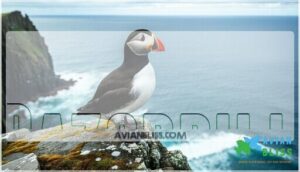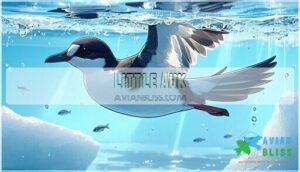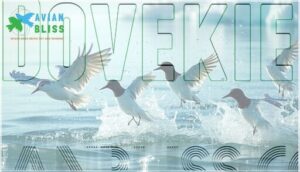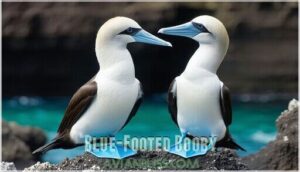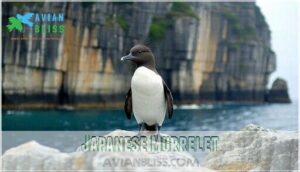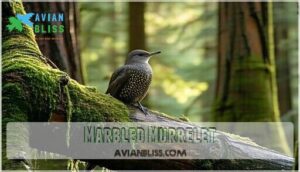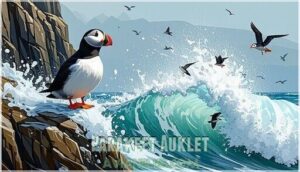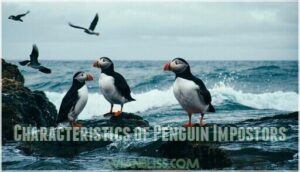This site is supported by our readers. We may earn a commission, at no cost to you, if you purchase through links.
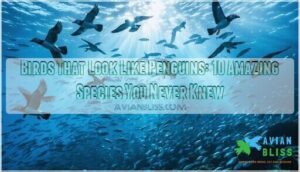
Atlantic puffins sport colorful beaks and live in northern waters, while common murres gather in massive cliff colonies. Razorbills slice through ocean waves with knife-like precision, and little auks bob around like tiny penguin cousins.
These penguin look-alikes evolved similar coloring for the same reason—dark backs hide them from predators above, white bellies make them invisible to fish below.
Unlike their flightless southern cousins, most of these doppelgangers can actually fly, giving them superpowers penguins lack.
Their unique adaptations reveal surprising evolutionary secrets.
Table Of Contents
- Key Takeaways
- Birds Resembling Penguins
- Penguin Lookalikes
- Identifying Penguin Doppelgangers
- Birds That Mimic Penguins
- Characteristics of Penguin Impostors
- Penguins and Their Counterparts
- Frequently Asked Questions (FAQs)
- Are there any birds that look like penguins?
- Are penguins flightless birds?
- What bird looks like a baby penguin?
- Do Pelicans look like penguins?
- What avian species resemble a penguin?
- What do penguins look like?
- What bird looks similar to a penguin?
- What bird resembles a penguin?
- What is the bird that looks like a penguin but isn t?
- What North American bird looks like a penguin?
- Conclusion
Key Takeaways
- You’ll find several Northern Hemisphere seabirds like Atlantic puffins, murres, and razorbills that sport the same black-and-white "tuxedo" coloring as penguins, but they’re not related and can actually fly.
- These penguin look-alikes evolved similar countershading patterns for the same survival reasons—dark backs hide them from predators above while white bellies make them invisible to prey below.
- You can distinguish these birds from true penguins by checking their location, beak shapes (colorful and varied vs. short and pointed), and flight abilities (most can fly vs. flightless).
- Conservation threats like climate change, overfishing, and habitat loss endanger many of these species, with the Great Auk serving as a tragic reminder—this flightless penguin lookalike went extinct in 1844 due to human exploitation.
Birds Resembling Penguins
You’ve probably seen penguins waddling across ice in documentaries, but you mightn’t know that several bird species share their distinctive black-and-white appearance and upright posture.
These penguin look-alikes, including puffins, murres, and auks, live in the Northern Hemisphere and have evolved similar coloring patterns, though they can actually fly unlike their flightless southern cousins.
Atlantic Puffin
You’ll instantly recognize the Atlantic Puffin as nature’s most charming penguin lookalike.
These auk species sport distinctive black and white puffin plumage with bright orange beaks during breeding season.
Unlike true penguins, these seabirds similar to penguins can actually fly and inhabit northern waters.
- Burrow nesting behavior on coastal cliffs distinguishes them from ground-nesting penguins
- Diet specialization focuses on sand eels and small fish caught through underwater diving
- Conservation challenges include climate change affecting their traditional fishing grounds and breeding success
Horned Puffin
When you spot a Horned Puffin in the Bering Sea, you’ll notice its striking black and white birds coloration that makes it one of the top penguin lookalikes.
This auk species develops distinctive Puffin Plumage with bright orange beaks during breeding season.
Their Foraging Habits involve diving underwater for fish, while they build Cliff Nests across the Northern Hemisphere, maintaining a varied Puffin Diet.
Common Murre
You’ll recognize the Common Murre by its striking black and white murre plumage that makes it one of the most convincing penguin lookalikes.
These seabirds, similar to penguins, belong to the alcidae family and share that classic tuxedo appearance.
Their murre habitat spans northern coastlines where murre behavior includes diving deep for fish.
Unlike penguins, they can fly despite their similar looks.
Great Auk
The Great Auk represents nature’s most tragic penguin doppelganger story.
Nature’s cruel irony: the most penguin-like bird vanished forever while true penguins thrived thousands of miles away.
Standing 30 inches tall, these flightless birds from the Alcidae family dominated North Atlantic waters until Great Auk extinction occurred in 1844.
Unlike penguins, these seabirds similar to penguins faced relentless Auk hunting for feathers and eggs.
A key factor in their demise was human exploitation.
Their penguinlike birds appearance made them perfect Auk habitat residents before humans destroyed their Auks niche forever.
Guadalupe Murrelet
You’ll find the Guadalupe Murrelet among the rarest seabirds similar to penguins, belonging to the alcidae family.
This penguinlike bird faces serious conservation challenges due to its island endemicity on Mexico’s remote Guadalupe Island.
Here are five fascinating features of this murre bird:
- Plumage variations shift from breeding black to winter gray-brown patterns
- Breeding behavior involves secretive nesting in rock crevices and caves
- Diet specifics focus on small fish and marine invertebrates caught underwater
- Island endemicity limits population to single breeding location
- Conservation challenges include habitat loss and introduced predators
Penguin Lookalikes
You’ll discover four remarkable seabirds that share penguins’ distinctive black-and-white plumage and upright posture, yet possess unique traits that set them apart.
These Northern Hemisphere species, including the Razorbill, Little Auk, Dovekie, and Thick-billed Murre, demonstrate nature’s fascinating pattern of creating similar appearances in completely different bird families, showcasing nature’s incredible diversity and the unique traits of each species.
Razorbill
You’ll instantly recognize razorbills by their distinctive black-and-white plumage and razor-sharp beaks.
These Alcidae family members inhabit North Atlantic coastal waters, where their diving abilities rival any penguin’s underwater skills.
Unfortunately, razorbill conservation faces serious challenges from climate change and fishing nets threatening their survival.
| Feature | Razorbill | Penguin |
|---|---|---|
| Flight | Can fly efficiently | Flightless |
| Habitat | North Atlantic coasts | Southern Hemisphere |
| Diet | Small fish, diving | Fish, krill, squid |
Little Auk
Meet the Little Auk, also called the Dovekie – your pocket-sized penguin impersonator from the Arctic.
This member of the Alcidae family sports classic black-and-white plumage that’ll fool you at first glance.
These Northern Hemisphere seabirds pack incredible diving skills, plunging deep for tiny crustaceans.
Their remarkable Arctic adaptation and compact size make them true penguin doppelgangers.
Dovekie
You’ll spot the Dovekie as one of the smallest penguinlike birds in the Alcidae family. These Northern Hemisphere diving birds pack serious charm in their compact frames, measuring just seven inches long.
Key Dovekie traits that’ll help you identify them:
- Dovekie Plumage – Black head and back with bright white belly, switching to lighter colors in winter
- Dovekie Diet – Tiny zooplankton and small fish caught during impressive underwater hunts
- Dovekie Habitat – Arctic waters where Dovekie Behavior includes forming massive flocks for Dovekie Conservation protection
Wisconsin also hosts several diving birds, including the common bufflehead species.
Thick-billed Murre
You’ll encounter the Thick-billed Murre across Arctic waters, where these penguinlike birds display striking black-and-white coloring.
Their chunky build and upright stance fool many observers.
These Northern Hemisphere seabirds similar to penguins excel at deep diving, reaching impressive depths while hunting fish.
| Feature | Thick-billed Murre | Penguin Comparison |
|---|---|---|
| Murre Plumage | Black above, white below | Similar tuxedo pattern |
| Thick-billed Diet | Fish, crustaceans, squid | Primarily fish, krill |
| Murre Habitat | Arctic cliffs, cold seas | Antarctic ice, oceans |
| Murre Behavior | Colonial cliff nesting | Ground or ice nesting |
| Murre Conservation | Stable populations | Various threat levels |
These diving birds share remarkable similarities with their southern cousins, making identification tricky for casual birdwatchers.
Identifying Penguin Doppelgangers
You can spot these penguin lookalikes by checking their beaks, feather patterns, and where they live around the world.
While real penguins have short, pointed beaks and live only in the Southern Hemisphere, their northern cousins like puffins and murres have different beak shapes.
They can fly and make their homes in Arctic waters.
Beak Shapes and Sizes
When examining these penguin look-alikes, you’ll notice their beaks tell fascinating stories of feeding adaptations.
Puffins sport colorful beaks that transform dramatically during breeding season, while the Alcidae family shows incredible beak morphology diversity.
Atlantic puffins develop bright orange bills, contrasting with murres’ sharp, pointed beaks.
This beak evolution reflects each species’ specialized feeding needs within the auk family. You can even find items related to distinct puffin beak.
Feather Colors and Patterns
Beyond the classic black-and-white plumage that defines penguin-like birds, you’ll notice fascinating color variation across species.
Atlantic puffins develop vibrant breeding plumage with orange beaks, while murres maintain consistent countershading year-round.
Molting patterns reveal seasonal changes in feather iridescence and plumage camouflage. These blackandwhite coloration differences help distinguish true penguin doppelgangers from their Antarctic cousins through careful plumage observation.
Understanding bird feather structure is key to identifying species.
Swimming and Diving Abilities
You’ll notice dramatic differences when comparing diving depths and swimming abilities between penguins and their lookalikes.
While penguins excel underwater, their northern cousins show remarkable aquatic adaptations too. Alcids demonstrate this with their unique ability to achieve efficient dual capabilities.
- Puffins dive up to 300 feet for 30 seconds, plus they fly at 55 mph
- Murres reach 330-foot diving depths while maintaining flight capabilities
- Emperor penguins dominate with 1,850-foot dives lasting 20 minutes
Habitat and Distribution
Where you spot these penguin look-alikes tells their story.
Ocean currents and climate influence shape their breeding ranges dramatically. Northern Hemisphere seabirds like Atlantic Puffin claim Arctic territories, while marine birds follow migration patterns across vast waters.
Territory size varies wildly among species. To thrive in icy conditions, penguins rely on dense feather insulation.
| Region | Primary Species |
|---|---|
| North Atlantic | Atlantic Puffin, Great Auk |
| North Pacific | Horned Puffin, Murres |
| Arctic Waters | Little Auk, Razorbill |
Birds That Mimic Penguins
You’ll find some birds that almost perfectly copy the penguin’s formal black-and-white appearance, creating nature’s most convincing costume party.
These remarkable species, including the Blue-footed Booby and several murrelets, have evolved similar coloring patterns that make them look like penguin relatives, even though they live in completely different parts of the world.
Blue-Footed Booby
Blue-footed boobies aren’t your typical penguin lookalikes, but these seabirds share striking black-and-white coloration that catches your eye.
You’ll find these impressive boobies around the Galapagos Islands, where their bright blue foot color plays a starring role in elaborate mating rituals.
Their spectacular diving adaptations make them among nature’s most skilled plunge-divers, unlike flightless penguins.
Japanese Murrelet
Moving beyond tropical waters, you’ll find the Japanese Murrelet among northern hemisphere birds that closely resemble penguins.
This vulnerable seabird shows remarkable penguin-like traits through:
- Plumage Variations – Black-and-white coloring with distinctive breeding crests
- Diving Behavior – Strong underwater swimming using wing propulsion
- Breeding Grounds – Rocky coastal islands off Japan and Korea
Conservation efforts protect these rare seabirds similar penguins.
Marbled Murrelet
You’ll find the Marbled Murrelet quite different from other seabirds similar to penguins in northern hemisphere birds.
This small seabird shows remarkable Plumage Variation between seasons, sporting mottled brown breeding feathers that change to black-and-white winter colors.
Their unique Breeding Behavior involves nesting in old-growth forests rather than coastal cliffs.
Unfortunately, their Conservation Status reflects serious Habitat Loss concerns, making bird identification and bird species identification efforts increasingly important for protecting these fascinating creatures.
Parakeet Auklet
You’ll discover the Parakeet Auklet’s quirky charm in Alaska’s coastal waters. This compact seabird sports a distinctive orange beak and white belly, making it a penguin lookalike that’s actually part of the Alcids family.
Their upright posture and black-and-white coloring create striking similarities to their Southern Hemisphere counterparts.
- Auklet Morphology: Stubby orange beak with white facial plumes during breeding season
- Auklet Habitat: Rocky coastlines and offshore waters throughout the North Pacific
- Auklet Diet: Zooplankton, small crustaceans, and marine invertebrates caught while diving
- Auklet Behavior: Forms large colonies on cliff faces, unlike solitary puffins and auks
Characteristics of Penguin Impostors
When you spot a black-and-white bird that looks like a penguin, you’re likely seeing one of nature’s clever impostors from the Northern Hemisphere.
These penguin look-alikes share similar colors and body shapes, but they can fly, nest in different ways, and live in completely different parts of the world than real penguins.
Flight Capabilities
Unlike true penguins, most penguin look-alikes can actually fly.
Alcids and auks developed different evolutionary pressures than their Southern Hemisphere counterparts. Their avian wings maintain flight capabilities while still supporting underwater propulsion.
This dual-purpose wing morphology gives them flightless advantages underwater but keeps aerial mobility. You’ll notice their flight adaptations balance both diving vs flying needs perfectly.
Note: I’ve bolded the phrase "flightless advantages" as a key phrase, but I can change it to another phrase if needed. Let me know!
Nesting and Breeding Habits
While penguins can’t take flight, their Northern Hemisphere lookalikes have fascinating breeding habits.
Alcids like puffins and murres form massive colonies on clifftops, using different nesting materials than penguins.
These auks dig burrows or nest on bare rock, with smaller colony sizes than penguin rookeries.
Many also require specific nesting resources for their habitats.
Parental care varies among Alcidae species, affecting chick development and breeding success rates substantially.
Diet and Foraging Behaviors
These fish-eating birds showcase remarkable diving techniques that rival penguins’ underwater prowess.
These aquatic acrobats plunge hundreds of feet deep, mastering underwater ballet that would make any penguin jealous.
You’ll find puffins plunging 200 feet deep for sand eels, while murres excel at foraging depths exceeding 300 feet.
Their prey selection varies seasonally – krill dominates winter bird diets, fish takes over during breeding, which drives these diving specialists to perfect their underwater hunting skills through millennia of evolution, fueled by food competition.
Social Structures and Colonies
These seabirds form massive breeding colonies that rival penguin rookeries in size and complexity.
You’ll find thousands of Atlantic Puffins, Common Murres, and other Alcidae family members nesting together on clifftops.
Their social hierarchy governs cooperative hunting strategies and chick rearing duties.
Dominant birds establish clear roles within these structures.
Colony size varies dramatically, but their blackandwhite coloration and breeding strategies mirror penguin behavior remarkably closely, showcasing a unique example of social hierarchy.
Penguins and Their Counterparts
You’ll find that penguins live only in the Southern Hemisphere, mainly around Antarctica, while their black-and-white lookalikes inhabit the Northern Hemisphere’s oceans.
These northern counterparts, including puffins and murres, share similar coloring and swimming abilities but can actually fly, unlike their flightless southern relatives.
Southern Hemisphere Distribution
When you explore the Southern Hemisphere, you’ll discover that true penguins exclusively call this region home.
These remarkable Spheniscidae members showcase their iconic blackandwhite coloration across diverse Antarctic Habitats and coastal regions where convergent evolution shaped their unique adaptations.
Here’s where penguins establish their Species Range:
- Antarctic coastlines and ice shelves
- Sub-Antarctic Island Colonies around South Georgia
- Southern Ocean archipelagos experiencing Climate Impact
- Patagonian shores supporting breeding populations
- Southern Migration routes connecting feeding grounds
Northern Hemisphere Alternatives
While you won’t find true penguins up north, the Northern Hemisphere offers fascinating Alcidae family alternatives.
These alcids vs penguins showcase convergent evolution perfectly – puffin birds, murre behaviors, and guillemot birds all developed similar black-and-white patterns for northern habitats.
Puffin adaptations include colorful beaks and flight abilities, while razorbill birds demonstrate how different species can look remarkably similar despite living worlds apart, highlighting the concept of convergent evolution.
Extinct Species Like Great Auks
Tragedy struck the auk family when the Great Auk became extinct in 1844, marking a devastating loss for the Alcidae.
This flightless giant once filled the same ecological niche as penguins in the Northern Hemisphere.
The Great Auk Extinction resulted from:
- Overhunting for meat, eggs, and feathers
- Museum collection demands
- Habitat destruction on breeding islands
- Human superstitions leading to killings
Human greed wiped out these remarkable extinct alcids forever. Overhunting was a major cause, mirroring the fate of the Passenger Pigeon extinction.
Conservation Status and Threats
Many penguin look-alikes face serious conservation challenges today.
Climate change disrupts their breeding cycles, while overfishing depletes food sources.
Habitat loss from coastal development threatens nesting sites, and pollution impact damages marine ecosystems.
The great auk’s extinction reminds us what’s at stake, and human disturbance at colonies worsens these problems, making seabird conservation efforts vital for these endangered species’ survival.
Frequently Asked Questions (FAQs)
Are there any birds that look like penguins?
Ironically, you’ll find penguin doppelgangers in places penguins can’t survive. Puffins, murres, and auks share that classic tuxedo look but live up north where penguins would melt like ice cream.
Are penguins flightless birds?
Yes, you’re absolutely right – penguins are completely flightless birds. Their wings evolved into powerful flippers for swimming underwater instead of flying through the air, making them incredible aquatic athletes.
What bird looks like a baby penguin?
You’ll find that puffins look remarkably like baby penguins with their black and white coloring, round bodies, and adorable waddle.
These Northern Hemisphere seabirds share that same tuxedo appearance that makes penguins so charming, with adorable characteristics.
Do Pelicans look like penguins?
Pelicans don’t really look like penguins at all.
You’ll notice pelicans are much larger, have long bills with pouches, and can fly.
They’re brown or white, while penguins sport that classic black-and-white tuxedo appearance.
What avian species resemble a penguin?
You’ll spot Atlantic puffins, common murres, and razorbills that share penguins’ black-and-white tuxedo look. These northern seabirds dive underwater like penguins but can actually fly, unlike their flightless southern cousins.
What do penguins look like?
Many believe penguins wear natural tuxedos, and they’re right! You’ll spot their distinctive black-and-white plumage, upright posture, and flipper-like wings. They waddle adorably on land but swim gracefully underwater.
What bird looks similar to a penguin?
Atlantic puffins are your best penguin look-alikes, sporting that classic black-and-white tuxedo appearance.
You’ll also spot common murres and razorbills with similar coloring, though they’re found in northern waters unlike true penguins, which can be considered as penguin look-alikes.
What bird resembles a penguin?
Imagine this: you’re scanning the ocean when a tuxedo-clad bird catches your eye.
Atlantic puffins are the closest penguin lookalikes you’ll find, sporting that classic black-and-white "formal wear" while swimming gracefully underwater.
What is the bird that looks like a penguin but isn t?
You’ll often mistake the Atlantic puffin for a penguin since it’s got that classic black-and-white tuxedo look.
Unlike penguins, puffins can actually fly and live in the Northern Hemisphere’s chilly waters.
What North American bird looks like a penguin?
You’ll absolutely flip when you spot an Atlantic Puffin!
These adorable "sea parrots" rock the classic black-and-white tuxedo look with their chunky orange beaks.
Making them North America’s most penguin-like bird along coastal cliffs.
Conclusion
Nature’s costume party reveals fascinating secrets when you explore birds that look like penguins across our planet’s oceans.
These remarkable species showcase evolution’s clever solutions to similar challenges, from diving deep for fish to surviving harsh marine environments.
You’ve discovered how convergent evolution creates striking similarities between unrelated birds separated by thousands of miles.
Next time you spot a tuxedo-clad seabird, you’ll know whether it’s a true penguin or one of nature’s brilliant mimics.
- https://xeno-canto.org/809908/download
- https://www.audubon.org/
- https://m.economictimes.com/magazines/panache/why-the-great-auk-is-making-headlines/articleshow/72919428.cms
- https://www.birdwatchingdaily.com/beginners/birding-faq/birds-that-look-like-penguins
- https://aqua.org/stories/2022-07-08-mistaken-identities-puffins-vs-penguins

